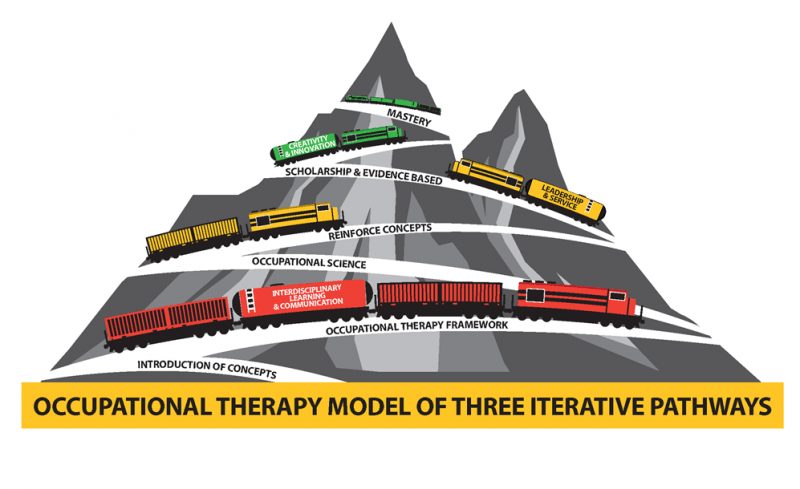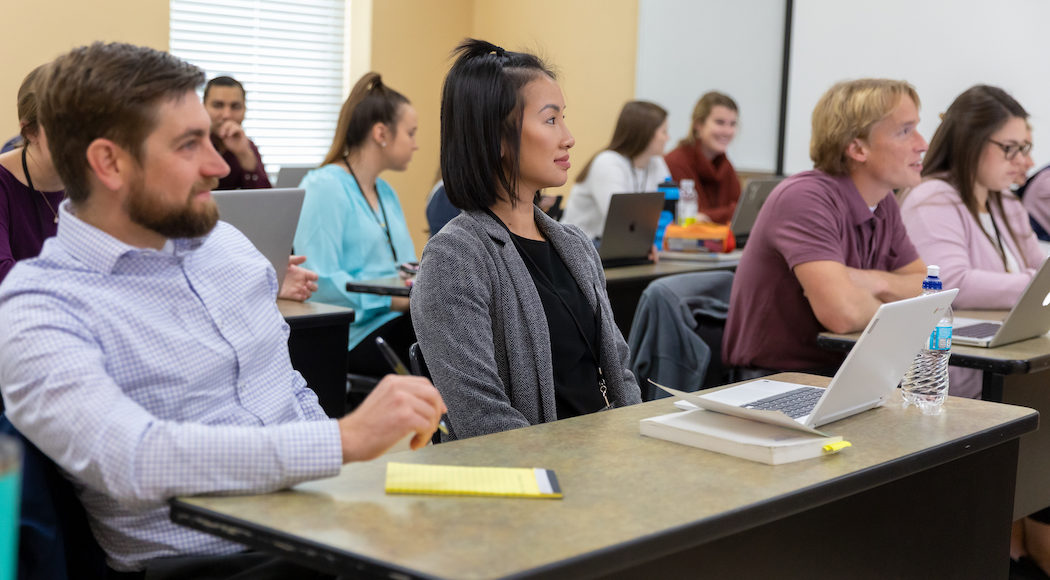MSOT Program Description
Overview
Pfeiffer University, Department of Occupational Therapy offers a Master’s of Science in Occupational Therapy. The MSOT program is designed for students who have a bachelor’s degree in fields other than occupational therapy which consists of 4 years of pre-professional preparation to obtain a bachelor’s degree before admission into the program. The full-time, 74 credits, 2 year MSOT program will be delivered in 24 months (6 semesters) beginning in September of each year. All courses are sequential and only one cohort of students is accepted per the calendar year. The educational program consists of academic coursework, supervised fieldwork experiences (24 weeks of level II FW). The rationale for a time frame is consistent with standards of graduate education for professional education and is comparable across other institutions. The cohort size will be 25-45.
This curriculum is designed to provide an excellent education for students planning for professional roles as occupational therapy practitioners in traditional settings, as well as in areas of newly identified needs or emerging practices, especially rural health. The occupational therapy program integrates students into a community of professional graduates, who seek to become caring and competent health professionals, and who value the unique synergies possible in an inter-professional educational approach. Pfeiffer University creates an environment that promotes a servant attitude and holistic approach to the care of all human beings encouraging the sharing of information and the teamwork approach found in today’s healthcare and rehabilitation professionals.
Course Sequence:
Fall – Year 1
- OT 800 Introduction to Occupational Therapy and Occupational Science (3hrs)
- OT 802 Anatomy & Kinesiology (4hrs)
- OT 804 Movement, Occupation, and Participation (5hrs)
- OT 810 Interprofessional Practice (1hr)
- OT 818 Documentation (online) (1hr)
Spring – Year 1
- OT 812 Foundations of Neuroscience (3hrs)
- OT 814 Mental Health & Wellness (4hrs)
- OT 842 Technology in Occupational Therapy (3hrs)
- OT 822 Inquiry and Evidence-based Practice (3hrs)
- OT 826 Fieldwork Level I- Mental Health (1hr)
Summer – Year 1
- OT 828 OT in Adults and Geriatrics (4hrs)
- OT 830 Occupational Performance, Evaluation & Assessment (Adults/Geriatrics) (4hrs)
- OT 816 Group Dynamics (3hrs)
- OT 836 Inquiry & Evidence-based Practice II (3hrs)
- OT 840 Fieldwork Level I- Adult (1hr)
Fall – Year 2
- OT 852 Occupational Therapy in Pediatrics and Youth (4hrs)
- OT 854 Occupational Performance, Evaluation & Assessment (Pediatric/Youth) (4hrs)
- OT 862 Fieldwork Level I- Pediatrics (1hr)
- OT 844 Orthotics/Physical Agent Modalities in Occupational Interventions (3hrs)
- OT 834 Contextual Population Health, Disparities & Factors (2hrs)
Spring – Year 2
- OT 866 Fieldwork Level IIA Adults or Pediatrics (6hrs)
- OT 848 Ethics in OT Practice (hybrid) (2hrs)
Summer – Year 2
- OT 856 Management in Health Care (hybrid) (3hrs)
- OT 873 Fieldwork Level IIB Adults or Pediatrics (6hrs)
Curriculum
The curriculum design emerges from and embodies the mission of Pfeiffer University, as well as the mission and philosophy of the Occupational Therapy Master’s program. The mission of Pfeiffer University embraces the concepts of academic excellence rooted in the Methodist tradition and based on the foundation of liberal arts education. The principle of servant leadership reflects the occupational therapy belief in assessing and treating the individual as a spiritual living being.

The MSOT program focuses on the development of creative leadership and forward-thinking occupational therapy practice. These roles require numerous iterations to integrate the multiple skills needed to contemplate and effectively propose solutions to rapid changing health, community and educational system. Our curriculum presents students with a learning environment and activities that facilitate adaptation and prepares them for the practice of occupational therapy and leadership roles.
The curriculum design metaphorically resembles a transformative journey with iterations providing the platform for the occupational therapy program outcomes:
- Leadership and Service
- Creativity and Innovation
- Interdisciplinary learning and Communication
These outcomes are consistent with the mission and philosophy of Pfeiffer University’s MSOT program. The ever-increasing spiral shape of the train journey is created by the centrality of occupational science and occupational therapy: the person (an individual, family, or community), the environment (space, place, time, or situation) and the occupation (everyday activities occupying our time such as care for self and others, work, education, and leisure).
Curriculum Model Three Iterative Pathways
The curriculum model is implemented through the three iterative pathways (Occupational Science, Occupational Therapy Framework, Scholarship and Research, and Application of Teaching/Learning Methods). Initial courses in the curriculum lay the foundation for skill development. Engagement in a variety of teaching/learning methods is used to give students opportunities to apply their knowledge and progress to mastery level. In our view, students’ capabilities depend upon the dynamic connections with prior experience and learning.
In a collaborative learning process, students and faculty seek to address the current evidence-based practice with a critical-thinking focus, (i.e., analyzing, synthesizing, evaluating and integrating complex information from diverse sources). The curriculum develops students’ skills and reinforces the reciprocal nature of information between propositional knowledge and practice knowledge. As this learning process evolves, the learner prepares for leadership roles with a forward-thinking attitude to deliver occupational therapy services. This model will also be reflected in our curricular goals and student outcomes.
One of the components of the curriculum will be the use of small group teaching methodologies, which include problem-based learning, student-led seminars, focused discussions, and role play. The approaches challenge students to “learn to learn,” and to work cooperatively in groups to seek solutions to real-world problems. It also encourages students to think critically and analytically and it is learner-centered. As the iterative curriculum unfolds, knowledge and available solutions will become increasingly complex.
Traversing the THREE ITERATIVE Curricular Pathways
| Foundations of OS | OT Framework | Scholarship & Research |
| Introduction to OT and OS (S1) | Documentation in OT (S1) | Inquiry and EBP I (S2) |
| Anatomy and Kinesiology (S1) | Movement, Participation, and Occupational Adaptation (S1) | Technologies in OT (S2) |
| Interprofessional Practice (S1) | Mental Health and Wellness (S2) | Inquiry and EBP II (S3) |
| Foundations of Neuroscience (S2) | Group Dynamics (S2) | |
| OT in Adults, Geriatrics (S3) | ||
| Performance, Evaluation & Intervention Adult (S3) | ||
| Management in Health Care (S6) | ||
| OT in Pediatrics and Youth (S4) | ||
| Performance, Evaluation & Intervention Pediatrics (S4) | ||
| Orthotics (S4) | ||
| Ethics (S5) | ||
| Fieldwork Level I A MH (S2), I B Adult (S3), & I C Peds (S4); Fieldwork Level II A (S5) & II B (S6) |
- S = semester, number is the number of semesters in sequence
- S5 = Fieldwork Level II A – consolidation of semesters 1 – 4, Adults or Pediatrics
- S6 = Fieldwork Level II B – consolidation of semesters 1 – 5, Adults or Pediatrics
- 74 credits total
Person-Environment-Occupation (PEO) Frame of Reference
The framework, which emerges from the curricular design, underscores three (3) major trajectories: PERSON–ENVIRONMENT-OCCUPATION (PEO).
- First, Occupational Science serves as the foundation for the curriculum and our understanding of occupational therapy practice. In this iteration, the program offers five courses that examine “PEO”- Anatomy and Kinesiology, Intro to Occupational Therapy and Occupational Science, Interprofessional Practice (1 & 2), Foundations of Neuroscience, Population Disparities and Factors, Professional Reasoning, Advanced OT and OS, and Functional Cognition and Rehabilitation.
- Second, the Occupational Therapy Practice Framework informs the larger content iterations emphasizing “PEO” in Intro to Occupational Therapy and Occupational Science, Movement, Participation, and Occupational Adaptation, Mental Health and Wellness, Group Dynamics, Clinical Medicine and Conditions, OT in Adults and Geriatrics, OT in Pediatrics/Youth. “PEO” is also threaded through in the performance, evaluation and intervention courses include Adults/Geriatrics, Children/Youth, Orthotics, Ethics, OT Management in Healthcare, Leadership and Advocacy, and OT Masters Professional Seminar. “Person-Occupation-Environment”also defines how we structure the content of the sciences and skills courses.
- Third, Scholarship and Evidence-Based Practice are essential for graduate-level occupational therapy education and are the emphasis of this iteration. Students critically examine evidence related to “PEO” in occupational therapy practice. The following ten courses shape this iteration: Technology in Occupational Therapy, Inquiry, and Evidence-Based I and II, Professional Reasoning, culminating in a final Masters Capstone project that demonstrates forward-thinking evidence-based occupational therapy practice in global communities.
Pfeiffer University’s MSOT program synergistically integrates Person-Environment-Occupation Model into the curriculum to educate students for practice by fulfilling the occupational performance roles in our curriculum model and sequence.
